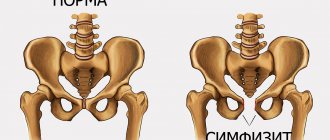Pregnancy is a mystery. Pregnancy is a miracle. Pregnancy is...sometimes a very exciting and stressful period in a woman’s life. Yes, modern future parents now have opportunities that could only be dreamed of 20 years ago. All kinds of genetic screenings, expensive tests and, most importantly, careful monitoring using ultrasound studies. This is a huge plus and progress in obstetrics and gynecology, if you look back at the recent management of pregnancy almost “blindly”.
What is ultrasound examination? And is it so important and informative that practically no doctor can do without it?
What is ultrasound
The ultrasound procedure has no contraindications
Ultrasound (ultrasound examination) is a study of the human body using ultrasonic waves, that is, without surgical intervention. This diagnosis is one of the most important in medicine. And although the first memories of it date back to the second half of the 19th century - the beginning of the 20th century, it began to be used in obstetrics about 40 years ago. In perinatal diagnosis even later - in the late 80s - early 90s.
Interestingly, the original and main purpose of ultrasound in obstetrics was to diagnose multiple pregnancies. Only later, already in 1976, the work of ultrasound research was aimed at identifying pathologies of intrauterine development.
How does this happen? Ultrasound passes through the boundaries between organs and tissues and is reflected from them in a certain way. These changes are recorded by a special sensor and translated into a graphic image, which is recorded on the monitor.
The procedure itself is simple, accessible and has no contraindications. That is why it is possible to carry it out repeatedly over several years, months, weeks and even a day, depending on the clinical situation.
How does an ultrasound machine work?
Before starting an ultrasound of a pregnant woman, the doctor lubricates the surface of her abdomen or the device’s sensor with a water-based gel. This is necessary so that the high-frequency sound wave, which is ultrasound, penetrates the skin. An ultrasound machine consists of a sensitive sensor connected to a computer, on the monitor of which the received data is displayed.
The operating principle of the device is as follows:
- When placed close to a pregnant woman's belly, the sensor emits ultrasound, which is imperceptible to the human ear. The doctor moves the sensor over the surface of the abdomen.
- Ultrasound passes unhindered through the gel film on the skin. Internal organs, tissues and fluid have different densities, so sound is reflected from them at different speeds .
- The sound wave echoes back to the sensor. The signal is transmitted through a wire to the computer and is displayed as a series of static pictures on the screen.
- The ultrasound specialist sees the readings and immediately deciphers the data received.
The ultrasound specialist continuously moves the sensor across the pregnant woman's abdomen to see the uterus from different angles.
The entire procedure lasts up to 15 minutes . Short-term exposure to ultrasound is safe for a pregnant woman.
The effect of ultrasound on pregnancy
The excitement of the expectant mother, who was given a referral for an ultrasound, is understandable. The maternal instinct is already working in full force and any “intervention” that concerns the baby causes fear and anxiety. Save, protect, protect... But sometimes you need to help and save. If the pregnancy proceeds without complaints or discomfort, the obstetrician prescribes two main screenings:
- At 12-14 weeks.
- 20-22 weeks.
- The third screening is at 30-32 weeks, carried out according to the doctor’s indications.
But! This is if the pregnancy is progressing normally. In case of unforeseen complications, ultrasound examination can be performed as many times as necessary to monitor the viability of the fetus.
And it makes no difference whether a pregnant woman had only two main ultrasounds, ten, or not at all. There are no precise data or laboratory studies that would confirm the detrimental effect of ultrasound diagnostics on the course of pregnancy. To prevent danger for the baby and help him in utero - yes. But no cases of harm were recorded. Therefore, the anxiety and fear of expectant parents is largely misplaced.
To do an ultrasound or not: which is more dangerous when carrying a child?
For women who doubt whether or not to do an ultrasound, doctors advise undergoing ultrasound diagnostics. For the mother and fetus, the lack of diagnosis is definitely more dangerous than the possible harm during its implementation. Reasons to do an ultrasound during pregnancy:
- Ultrasound allows you to recognize serious and dangerous pathologies of the placenta, pathology of the umbilical cord, pathological attachment of the umbilical cord, pathologies of the uterus, pathologies of the fetus, in which reconstructive operations after birth are possible;
- thanks to ultrasound, the doctor chooses the best method of delivery - natural birth or cesarean section, prepares an operating room for the mother or child if necessary, in case of serious pathologies during childbirth, a team of resuscitators and specialized specialists, for example, a pediatric cardiologist, is on duty, which can save lives and mother and baby;
- the mother’s good health during pregnancy does not guarantee the absence of pathologies in the fetus;
- without ultrasound results, there may be difficulties when registering for a maternity hospital, because without an ultrasound it is difficult for an obstetrician-gynecologist to draw up a birth plan and get a clear picture, and not all doctors are willing to take risks;
- childbirth is a responsible matter, the more information the doctor has, the higher the guarantee that everything will go according to plan;
- Without ultrasound results, the doctor delivering the baby will be overly nervous, which can negatively affect the birth process.
You can do an ultrasound fewer times only by the doctor’s decision; you should not skip the examinations yourself.
Video: is an ultrasound necessary during pregnancy?
At 36 weeks, based on the results of laboratory tests, my sister was sent for a fourth ultrasound. On the same day, Anya was caesareaned, and my nephew was born prematurely. Doctors literally saved him and his mother, because during the process of Doppler ultrasound, ultrasound detected a critical violation of blood flow. So I think an ultrasound should be done.
The effect of ultrasound on the fetus
Medicine has not identified any harmful effects of ultrasound on the fetus.
If ultrasound does not affect the course of pregnancy, then is it so harmless for the unborn baby?
It should be remembered that an ultrasound is not an x-ray. And ultrasonic waves are not x-rays. Ultrasound diagnostics, even of the highest power, is accompanied only by local heating of body cells. And this process in the scientific literature has never yet been accompanied by further identification of fetal anomalies.
But often, during an appointment, an obstetrician-gynecologist will advise his “pregnant ward” not to go for an ultrasound without indications and direction. Especially when it comes to the early stages. There are hypotheses (although not confirmed by laboratory studies) that early intervention in the form of ultrasound examination can lead to changes in the structure of the DNA of the embryo, developmental abnormalities, cancer in the future, and even provoke a miscarriage.
There is no official confirmation of these hypotheses. Exactly the same as refutations. But each organism is individual and even the most harmless procedure can sometimes cause unforeseen consequences. No one is immune from this, but strict adherence to the doctor’s recommendations and testimony will reduce the likelihood of a threat to the health of the baby and his mother.
Why do ultrasound diagnostics need to be done?
Scientists have proven that there is no harm from ultrasound during pregnancy. At the same time, this study can confirm or exclude a wide range of pathologies.
Indications for the procedure:
- establishing the fact of pregnancy and determining its obstetric period;
- fetal screening diagnostics (determining the number of embryos and placentation site, identifying anomalies, assessing presentation, position, calculating weight and establishing the expected date of birth);
- the pregnant woman has a history of severe somatic pathology (diabetes mellitus, hypertension, chronic glomerulonephritis or pyelonephritis, etc.);
- in vitro fertilization and/or ICSI;
- a history of spontaneous miscarriages, threatened miscarriage or ectopic pregnancy;
- the appearance of specific complaints of severe pain in the lower abdomen, bleeding from the genital tract, etc.
Is an ultrasound necessary during pregnancy?
Having heard about even the slightest danger of ultrasound examination for the fetus, a pregnant woman may refuse this procedure altogether. This is her right, but the obstetrician-gynecologist will most likely disagree with her.
The first two screenings are mandatory and contain the main information about the unborn child:
- 12-14 weeks - carried out mainly to exclude Down syndrome or other chromosomal pathology. The complex also includes tests for certain markers.
- 20-24 weeks - the size of the fetus already makes it possible to evaluate in detail its anatomical structure for the presence or absence of defects.
The third direction for ultrasound depends on the well-being of the expectant mother, the course of pregnancy and the results of the first two studies.
If a pregnant woman is not worried about anything, especially curiosity, she can easily get by with two trips to the ultrasound room. However, it should not be ignored. Modern medicine gives us such a chance to see our baby even before birth and, in case of danger, to help him. So why not take advantage of this?
When is an ultrasound performed?
The woman is offered to undergo the first examination for a short period of time during registration (10-14 weeks). This period is called the first trimester.
Ultrasound indications:
- risk of miscarriage;
- diagnosis of significant embryo deformities;
- detection of pathologies during the initial development of the fetal egg;
- exclusion of ectopic pregnancy;
- diagnosing multiple pregnancy;
- establishing the gestational age;
- established disorders in gynecology in the absence of menstruation;
- diagnosing hereditary diseases.
Timely detection of fetal development disorders allows future parents to decide on termination of pregnancy and avoid significant psychological stress and trauma due to the birth of a child with serious illnesses.
In the second trimester, a repeat ultrasound is required. Its duration is 20-24 weeks. At this stage, ultrasound makes it possible to discern the position of the child and the correspondence of development to the period of pregnancy, diagnose antiphospholipid syndrome, examine the placental condition, its size, localization of placental attachment and determine the sex of the child.
At this stage, the study helps doctors detect abnormalities in time and prescribe the correct appropriate treatment. Thus, when performing Doppler measurements (studying blood flow in the placental vessels), the later development of toxicosis (preeclampsia) is prevented. Prenatal diagnostics are also performed. The doctor thoroughly examines the ontogeny of the embryo and its organs “from the heels to the crown,” which allows timely detection of the development of congenital defects.
Indications for the third trimester include the location of the fetus, the study of intrauterine growth retardation (the child is born weak and underdeveloped), diagnosis of congenital defects (enlarged kidneys and enlarged ureter). Research in the third trimester helps specialists take objective measures to cure detected abnormalities.
Myths and truth about the dangers of ultrasound during pregnancy
Today there are 5 known myths about the harm of ultrasound on the fetus of a pregnant woman
Since future parents are not provided with reliable and official information about the dangers and safety of ultrasound diagnostics (due to the lack of this information), all sorts of rumors, “true” stories, fears begin to spread among them - in other words, myths about the dangers of ultrasound during pregnancy. Should they be debunked or are some of them actually valid? Let's see.
- MYTH No. 1. Ultrasound negatively affects the course of pregnancy and harms the fetus. There is no information to confirm or refute this. If the examinations are carried out according to the doctor’s indications and are not too frequent, there is no question of harm. An exception is ultrasound diagnostics in very early stages of pregnancy. And the reason is not the harmfulness of ultrasound, but the immaturity of the embryo’s organs, which are at the stage of formation.
- MYTH No. 2. The child experiences discomfort during an ultrasound examination. The baby is reliably protected by amniotic fluid, so he cannot suffer from ultrasonic waves - he simply does not feel them. Its activity is quite explainable by the mother’s excitement, a full bladder (which is a prerequisite when undergoing an ultrasound) and the touch of the sensor. But not painful sensations.
- MYTH No. 3. You should drink coffee before the examination. The baby's activity depends on the mother's posture - whether it is comfortable for him or not. In addition, the baby in the stomach moves almost constantly, but the mother only feels strong movements. The weaker ones are seen on ultrasound.
- MYTH No. 4. Ultrasound is unnatural. This is a subjective opinion and applies to everyone individually.
- MYTH No. 5. During an ultrasound, a child hears sound and sees light. The fact that during the examination the baby closes his eyes and ears with his hands, tugs at the umbilical cord and turns away does not mean that something is bothering him. He does this all the time. A child is playing, there are no other toys there.
The nature of ultrasound and how often it can be done
It is known that X-rays cannot be taken during pregnancy. Some patients, without really understanding it, came to the conclusion that any diagnosis could be harmful. It is not right. X-ray and ultrasound are fundamentally different techniques. If in the first case, minimal irradiation actually occurs, then in the second, the study is performed using ordinary high-frequency sound waves.
Ultrasound waves are located in a range inaudible to the human ear, but at the same time have the ability to penetrate tissue. Ultrasound reaches the structures of the embryo and is reflected from them with varying degrees of intensity, which leads to the formation of a picture on the screen of the device.
Due to the different densities of tissues and organs, the image is clear and informative. The structure of all structures of the embryo, as well as the uterus and placenta, is assessed.
In our country, the rules for the management of pregnancy by obstetricians are legally established. During normal pregnancy, a woman should be examined with ultrasound at least three times. The question of whether ultrasound is harmful or not is still open.
Each additional ultrasound scan must be justified and prescribed by the attending physician. You should not make a decision on an extraordinary ultrasound examination on your own, since numerous scientific hypotheses indicate a possible negative impact on the formation of the fetal brain.
Indications
These are so-called screenings at the 12th, 22nd and 32nd weeks of intrauterine development. The main task of such ultrasounds is to identify any threatening developmental disorders of the unborn child.
The 1st ultrasound confirms the presence of intrauterine pregnancy, determines the gestational age of the embryo, and reveals gross disturbances in the development of the unborn child.
The 2nd ultrasound is performed more closely, because by this time the organs and systems of the fetus are formed, the placenta is functioning at full capacity. When conducting an ultrasound scan, the correct formation of internal organs, the nervous system, and the functioning of the heart is assessed, and almost any congenital pathology is detected. This period of intrauterine development is very important in identifying chromosomal abnormalities. The structure of the uterus, placenta and the amount of amniotic fluid are also examined. In most cases, at 20-22 weeks it is already possible to determine the gender of the unborn baby.
The 3rd ultrasound is the final one in the normal course of pregnancy. The preliminary weight of the fetus is calculated, its position in the uterine cavity, the degree of maturity of the placenta, and the structure of the baby are determined. Very often, future parents can see the face of their child, since modern devices are capable of such an effect. If you wish, you can get the first photo of your child.
The effect of ultrasound on the fetus
Scientists have been researching the effects of ultrasound for decades. There are many hypotheses that claim that the effect of ultrasound on a developing pregnancy is negative.
- When exposed to an ultrasonic wave, tissues and organs at the site where the sensor is applied heat up by several degrees. Embryonic tissues are often subjected to similar heating. A local increase in temperature causes an increase in the permeability of cell membranes, which is accompanied by the possible penetration of substances of various natures into the cell.
- There is an opinion among scientists that when ultrasound is applied many times, this leads to the formation of tumors. No results were provided to support this hypothesis. There are only refuting results from experiments conducted on mice.
- It is assumed that ultrasound has a harmful effect on the development of organs and tissues in humans in the early stages of pregnancy. It is in the period up to 12 weeks that the formation of the unborn child occurs, so it is extremely undesirable to carry out an ultrasound examination during this period of time.
- Sonologists talk about changes in the course of enzymatic reactions in the embryo’s body during ultrasound scanning. These changes may have long-term consequences for the child.
- There are a number of theoretical scientists who claim that exposure to ultrasound causes chromosomal mutations in the fetus. To date, this idea has not been confirmed, and scientists have differing opinions on this matter.
- The opinion of most pundits is that focused ultrasound is the most dangerous. The use of this technique for a long time can cause various disorders in the fetus. It is recommended to use gentle modes and observe the temporary mode of exposure of the sensor to the unborn child.
- Most scientists agree that the fetal brain is subject to the greatest damaging effects, since it contains a considerable amount of water. In addition, it is the most blood-supplied organ, containing only nerve cells. In this regard, American psychiatrists associate the growth of patients with autism with frequent ultrasound examinations of the baby.
- The effect on the brain, according to some scientists, has led to an increase in left-handed children. The danger of ultrasound in this situation is associated with the possible underdevelopment of certain brain functions. There is also a “danger” for a child to become a genius.
In what cases is it necessary to perform an ultrasound during pregnancy?
There are a number of reasons when an ultrasound is simply necessary
In addition to mandatory examinations, the expectant mother may be referred by her obstetrician for an unscheduled ultrasound examination. The reason for this will be the well-being of the pregnant woman. If she is worried about abdominal pain, spotting, constant increased activity of the baby or, conversely, the lack of his movements, this is a reason for concern and play it safe with the help of an ultrasound.
But sometimes a pregnant woman feels well, and comments appear at the doctor’s office. For example, the size of the uterus does not correspond to the duration of pregnancy, there is a suspicion that the child is lying incorrectly, or tests are far from normal. In any of these cases, additional ultrasound will be necessary. First of all, for the baby. After all, if he is in danger, help will need to be provided immediately. And to do this, you need to find out the cause and eliminate it.
What is this procedure
Ultrasound is a procedure for studying internal organs using a sensor (transducer), which emits ultrasonic vibrations when in contact with the body, penetrates the tissue and is reflected, as a result, the image is transmitted to the computer screen.
- Two-dimensional - fuzzy black and white image.
- Three-dimensional – color and three-dimensional image, the fruit can be easily seen.
- Four-dimensional – a realistic picture, the child’s movements are visible.
It is carried out in two ways: vaginally (the sensor is inserted into the genital organ) and abdominally (the transducer is installed on the abdominal wall).
The examination of static organs is actively used; the procedure allows you to measure objects in motion (Doppler effect). This is especially important for pregnant women. The process separates the circulatory system of the woman in labor from the fetal system, which makes it possible to correctly evaluate the work and recognize pathologies.
Ultrasound examination is painless and safe.
Ultrasound during pregnancy allows you to see:
- development of the nervous, digestive and genitourinary systems;
- skeletal structure;
- work of the heart muscle;
- Down syndrome, Edwards syndrome;
- chromosomal abnormalities;
- location and functioning of the placenta;
- amount of amniotic fluid;
- fetal position;
- number of embryos.
Before the examination, it is recommended to abstain from carbonated drinks, grapes and nuts. You must take a disposable diaper with you to the procedure.
Is it worth doing an ultrasound in early pregnancy?
Ultrasound in early pregnancy involves examination up to 12 obstetric weeks. It has already been mentioned that 12-14 weeks is the time for the first screening. Why perform an ultrasound earlier than this period? After all, the fetus is not yet formed, therefore, such an examination will not be informative.
But! This is if you are already 100% sure that you are really pregnant. And if not? Then, at 5-7 weeks of the expected period, you can do an ultrasound to exclude ectopic pregnancy and the correct location of the fertilized egg (the fetal sac with a diameter of 2-3 mm can be seen already at 4 weeks and 3 days using a vaginal sensor). And at 8-9 weeks you will hear the cherished heartbeat. More frequent monitoring is determined by the condition of the pregnant woman and the first ultrasound. After all, for example, such a diagnosis as placental abruption requires constant monitoring. Then the harm from the ultrasound itself at such an early stage fades into the background.
Reasons why ultrasound should not be done frequently
Opponents of the procedure justify the harm due to mechanical effects on soft tissue. Frequent exposure to ultrasound can injure the abdominal wall and internal organs.
But the fluctuations are so small that they do not have a negative effect on a person. This has been proven and you can even verify it yourself; after the sensor comes into contact with tissue, no traces remain. The skin is of normal color and without pigmentation.
There are no contraindications to ultrasound, the only period when it is not recommended is when the uterus is toned and at too early a stage. But sometimes going through the procedure is pointless:
- during obvious labor;
- heavy bleeding;
- severe condition of a woman in labor requiring rapid delivery.
How does it affect the fetus?
The study can have an effect on the fetus with constant, long-term exposure. The standard procedure lasts only a few minutes, which is safe and harmless. In addition, modern equipment is regularly improved and everything possible is done to minimize risks.
How does it affect mom?
Ultrasound does not cause any sensations and is harmless to a woman if performed on a working device and by a specialist. The main recommendation: do not conduct the study in the first three weeks and when the uterus is toned, but this depends on the characteristics of the body and is determined by the observing doctor.
The vast majority of gynecologists recommend ultrasound examination for women who are expecting a child. The procedure is safe and painless. Timely detection of defects and diseases makes it possible to adjust treatment and further management of pregnancy.
Is it worth doing an ultrasound in the second trimester of pregnancy?
An ultrasound scan at 18-22 weeks of pregnancy is considered the safest for the fetus.
The most optimal and safe period for performing an ultrasound examination is 18-22 weeks of pregnancy. This type of ultrasound is also called anatomical. The fruit is already large enough to be assessed for the absence/presence of defects.
If the data from such a study are normal, then the pregnant woman will no longer have to undergo additional ultrasound scans, since there will be no informational benefit from them.
Conclusion
In conclusion, it is worth saying that ultrasound during pregnancy is undoubtedly a very important diagnostic method, which cannot be avoided now, although its effect has not been sufficiently studied. However, in practice for more than half a century, there have been no cases where ultrasound would lead to congenital malformations or diseases of a pregnant woman.
This means that you should not refuse an ultrasound examination, nor should you skip regular examinations, because a pregnant woman cannot replace this diagnosis in any way.
Is it necessary to do an ultrasound in the third trimester of pregnancy?
In a normal pregnancy, there is no need for ultrasound monitoring in the third trimester. The only exception is the period before childbirth, when the doctor needs to know the level of placentation, how the fetus is located, what the approximate size of your baby is and whether there is any entanglement in the umbilical cord.
All this information is very important during childbirth, because the obstetrician must be prepared for anything. It should be noted that sometimes ultrasound does not provide complete information about the baby. It all depends on the equipment and on the professional skills of the ultrasound specialist.
Ultrasound with Dopplerography
Doppler ultrasound is performed after the 30th week. By this time, all organ systems have already been formed, therefore the use of too powerful ultrasonic waves does not harm the child. However, supporters of minimal intervention in the body of a pregnant woman insist on performing Doppler only when indicated.
The third (final) ultrasound examination reveals:
- state of intrauterine development of the fetus;
- degree of maturity of the placenta;
- presentation (as a rule, it will not change until the moment of delivery);
- the presence of entanglement;
- motor activity;
- heart rate.
Ultrasound determines the tactics of managing a pregnant woman in the last trimester, the method of delivery, the need for drug therapy or a special diet (for a particularly large fetus). Based on the data obtained, a decision is made on the early placement of the woman in labor in the hospital maternity ward for full-term childbearing and enhanced monitoring by specialists.
It is strictly not recommended to carry out 3D and 4D diagnostics for pregnant women, as well as video recording of the procedure. Despite the newness of these types of studies, there is a suspicion that such ultrasound for the fetus can be dangerous. It can be carried out once during the 30-40th week of pregnancy and as an emergency measure for medical reasons.
Disputes about the dangers of ultrasound: who is right (arguments against, arguments for)
There is no exact answer: is ultrasound harmful?
Suggestions that ultrasound is harmful have appeared quite recently. Since before the benefits of it were so obvious and, to some extent, fantastic, that they didn’t even think about the other side.
Now there are fierce debates in the medical field and beyond: is ultrasound harmful? And how often, in what cases is it appropriate?
Arguments for"
Using ultrasound, careful monitoring of the course of pregnancy and intrauterine development of the child is carried out month by month. Namely:
- The viability of the fetus or its death is determined.
- The exact gestational age and estimated date of birth are given.
- The condition of the placenta and amniotic fluid is assessed.
- A multiple pregnancy is diagnosed. As well as possible congenital developmental pathologies and their severity.
- The baby's growth and weight gain are monitored.
- Contains information about the gender of the child.
Arguments against"
At the end of the working day, specialists who conduct ultrasound examinations feel a headache, severe fatigue and body aches. In the USSR they were even paid extra for the harmfulness of their work. But a 10-minute study cannot be compared to a full day's work. Just as the body of an unborn baby and an adult are not comparable.
Other dangers (such as the likelihood of DNA changes, cancer and developmental disorders) have not been scientifically proven and are often purely subjective opinions.
Negative effects of ultrasonic waves
Opponents of ultrasound examination consider all possible deviations in the development of children that can be caused by ultrasound during pregnancy. Now diagnostics are carried out using third-generation ultrasound scanners. Few research centers still have old devices. The new equipment is characterized by high quality control of radiation power.
According to scientific research that experts carried out back in the 70s (using old equipment), no negative impact on the development of the embryo was recorded.
Is 3D ultrasound harmful to the fetus?
There is an opinion that 3D ultrasound waves are more powerful than conventional ultrasound, this is a myth.
3D ultrasound is a three-dimensional study that makes it possible to obtain a three-dimensional color image of the fetus as a whole and individual parts of its body. In principle, it is no longer different from a regular ultrasound.
There is an opinion that 3D ultrasonic waves are more powerful and have a negative effect on the baby’s intrauterine development. But, firstly, this has not been proven. Secondly, any ultrasound examination within 30 minutes is safe for the mother and the unborn child. Thirdly, a lot depends on the ultrasound machine itself. The main thing is not to abuse this diagnosis for the sake of curiosity or “just because.”
Why are some people against it?
Disputes on such a topic as ultrasound during pregnancy: is it harmful or not, appeared for a reason. Some opponents of ultrasound argue that the vibrations generated by the waves can trigger the growth of tumor cells in the body. However, there is no evidence for this theory. The harmlessness of ultrasound is confirmed by positive practical experience.
You can also find references to the fact that ultrasound supposedly has a pronounced destructive effect on human tissues and organs. Scientists have refuted this theory as well. It is enough to evaluate the skin to which the sensor was applied. Even a mild allergic reaction, not to mention necrosis, has never been recorded.
As mentioned above, high-frequency waves are not retained at all in the body of the subject.
Long-term consequences of ultrasound
Since this kind of research is relatively new in obstetric practice, its long-term consequences are not yet known. In addition, the lack of “purity of the experiment” will prevent them from being determined. Indeed, genetics and environmental influences should also be added to the sources of potential danger to the health and development of a child.
You can debate for a long time on the topic “is ultrasound harmful during pregnancy and does it affect the fetus” and still not come to a common decision. But, if it is accepted, it will most likely be purely subjective. After all, each organism is individual, as is the influence on it. You just have to remember that nothing in medicine is absolutely safe. And if you neglect the recommendations of doctors, the consequences will not keep you waiting.
Debunking myths
In order not to be afraid and not to test the patience of the attending physician, every pregnant woman should understand where the truth is and where the fiction is. Therefore, it is worth understanding all the nuances of ultrasound diagnostics of the fetus and finding out whether ultrasound is harmful to the developing organism.
Poorly affects prenatal development
As a result of studies conducted to identify long-term effects of ultrasound on fetal development, not a single fact was found confirming its harmfulness. It is worth saying that the benefit has also not been established. Based on these data, it can be argued that following the prescriptions of an obstetrician cannot harm the course of pregnancy.
Does DNA change?
Garyaev’s hypothesis that ultrasound can affect the structure of DNA and lead to its mutation was not confirmed by various studies on white mice. It was established that after half an hour of exposure to ultrasonic waves on pregnant mice, DNA mutations did not occur. Similar experiments on pregnant women were not carried out for ethical reasons.
Therefore, it is difficult to say how harmful ultrasound is during pregnancy. Scientists claim that when passing through the tissues of the body, the signal can cause mechanical vibrations, therefore, manipulation should not be performed at a time when organs and tissues are being laid down.
This is unnatural
As they say, how many people, so many opinions. Each person may have their own view of health safety. Supporters of naturalness and closeness to nature have a negative attitude towards any effects on the body. Any pregnant woman can agree or refuse an ultrasound.
Modern technologies and danger for the baby
Technological progress does not stand still, and medicine is no exception. In recent years, the 3D diagnostic procedure has become very popular among expectant parents. But opponents of the procedure immediately declared the dangers of this examination. How does three-dimensional ultrasound differ from classical ultrasound?
3D ultrasound is exactly the same procedure as a regular ultrasound. But the difference is that the image on the monitor screen is color, not black and white, and at the same time more voluminous.
This small nuance allows you to obtain more accurate and objective data about the baby’s health condition. With 3D ultrasound, it is possible to detect pathologies and developmental anomalies that are inaccessible to two-dimensional devices. But there is still harm from the procedure. The frequencies at which 3D ultrasound machines operate are more powerful, and therefore the impact on the child increases several times. That is why the earliest date at which the procedure is allowed is the 32nd week. During the entire pregnancy, such an examination can only be done once. But parents will remember the impressions that remain from such a diagnosis for the rest of their lives. During a 3D ultrasound, you can see the most subtle features of the baby’s face, all the small organs and parts of the body. You can also record the procedure itself on video and get a three-dimensional photo of the baby. Despite the fact that the harmfulness of ultrasound has not been proven, this procedure should not be abused. Three scheduled screenings are quite enough to make sure that everything is fine with the baby and mother. Any additional procedures must be agreed upon with the attending physician, who can assess the balance of harm and benefit from this procedure for the fetus.
Author: E. Kubina
Is ultrasound harmful to humans?
The procedure itself takes no more than a quarter of an hour and its results are available to the doctor almost instantly. This allows you to decide what actions and how urgently should be taken in a given situation.
For this reason and due to the high information content of this diagnostic method, even cardiac ultrasound (echocardiography) is often used in clinical practice. Is heart ultrasound harmful? There are no contraindications identified for this procedure:
- it does not harm either the skin or the body itself;
- absolutely painless;
- Since it does not have a cumulative effect, it can be repeated many times.
In other words, it is completely harmless for the body to do ultrasound frequently. This fact is very important, since there is a real opportunity to monitor the dynamics of the disease and the effectiveness of the treatment.
However, what is harmless for an adult organism can negatively affect the health of a tiny person developing under the mother’s heart.
How does the child feel during the ultrasound scan?
Approximately half of the women feel the baby moving during the study. But how much this is related to the influence of ultrasound can only be guessed. Perhaps this is how the baby is affected by the tone of the uterus, which appears during the mechanical movement of the device’s sensor. But the indisputable fact is that in most cases the motor activity of the fetus increases during scanning. And while the negative effects of ultrasonic waves have not yet been proven, their painlessness for the baby cannot be completely denied.







